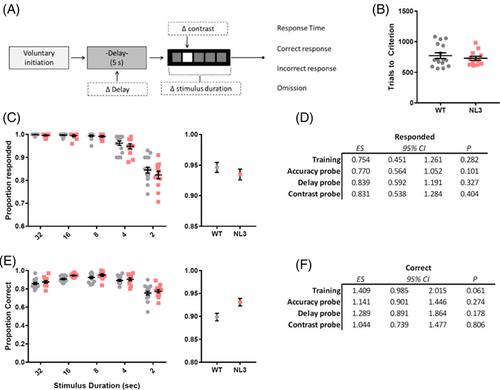当前位置:
X-MOL 学术
›
Genes Brain Behav.
›
论文详情
Our official English website, www.x-mol.net, welcomes your
feedback! (Note: you will need to create a separate account there.)
Mice with an autism-associated R451C mutation in neuroligin-3 show a cautious but accurate response style in touchscreen attention tasks
Genes, Brain and Behavior ( IF 2.4 ) Pub Date : 2021-06-04 , DOI: 10.1111/gbb.12757 Emma L Burrows 1 , Carlos May 1 , Thomas Hill 1 , Leonid Churliov 2 , Katherine A Johnson 3 , Anthony J Hannan 1, 4
Genes, Brain and Behavior ( IF 2.4 ) Pub Date : 2021-06-04 , DOI: 10.1111/gbb.12757 Emma L Burrows 1 , Carlos May 1 , Thomas Hill 1 , Leonid Churliov 2 , Katherine A Johnson 3 , Anthony J Hannan 1, 4
Affiliation

|
One of the earliest identifiable features of autism spectrum disorder (ASD) is altered attention. Mice expressing the ASD-associated R451C mutation in synaptic adhesion protein neuroligin-3 (NL3) exhibit impaired reciprocal social interactions and repetitive and restrictive behaviours. The role of this mutation in attentional abnormalities has not been established. We assessed attention in male NL3R451C mice using two well-established tasks in touchscreen chambers. In the 5-choice serial reaction task, rodents were trained to attend to light stimuli that appear in any one of five locations. While no differences between NL3R451C and WT mice were seen in accuracy or omissions, slower response times and quicker reward collection latencies were seen across all training and probe trials. In the rodent continuous-performance test, animals were required to discriminate, and identify a visual target pattern over multiple distractor stimuli. NL3R451C mice displayed enhanced ability to attend to stimuli when task-load was low during training and baseline but lost this advantage when difficulty was increased by altering task parameters in probe trials. NL3R451C mice made less responses to the distractor stimuli, exhibiting lower false alarm rates during all training stages and in probe trials. Slower response times and quicker reward latencies were consistently seen in NL3R451C mice in the rCPT. Slower response times are a major cognitive phenotype reported in ASD patients and are indicative of slower processing speed. Enhanced attention has been shown in a subset of ASD patients and we have demonstrated this phenotype also exists in the NL3R451C mouse model.
中文翻译:

在 neuroligin-3 中具有自闭症相关 R451C 突变的小鼠在触摸屏注意力任务中表现出谨慎但准确的反应方式
自闭症谱系障碍 (ASD) 最早可识别的特征之一是注意力改变。在突触粘附蛋白 neuroligin-3 (NL3) 中表达 ASD 相关 R451C 突变的小鼠表现出受损的相互社会互动以及重复和限制性行为。这种突变在注意力异常中的作用尚未确定。我们在触摸屏室中使用两项既定任务评估了雄性 NL3 R451C小鼠的注意力。在 5 种选择的连续反应任务中,啮齿动物被训练去注意出现在五个位置中任何一个位置的光刺激。虽然 NL3 R451C之间没有区别和 WT 小鼠的准确性或遗漏,在所有训练和探测试验中都观察到较慢的响应时间和较快的奖励收集延迟。在啮齿动物连续性能测试中,动物需要在多个干扰刺激下辨别和识别视觉目标模式。NL3 R451C小鼠在训练和基线期间任务负荷较低时表现出增强的注意刺激的能力,但在通过改变探测试验中的任务参数增加难度时失去了这种优势。NL3 R451C小鼠对干扰刺激的反应较少,在所有训练阶段和探测试验中表现出较低的误报率。在 NL3 R451C中始终可以看到更慢的响应时间和更快的奖励延迟rCPT 中的小鼠。较慢的反应时间是 ASD 患者报告的主要认知表型,表明处理速度较慢。在 ASD 患者的一个子集中显示出增强的注意力,我们已经证明这种表型也存在于 NL3 R451C小鼠模型中。
更新日期:2021-06-04
中文翻译:

在 neuroligin-3 中具有自闭症相关 R451C 突变的小鼠在触摸屏注意力任务中表现出谨慎但准确的反应方式
自闭症谱系障碍 (ASD) 最早可识别的特征之一是注意力改变。在突触粘附蛋白 neuroligin-3 (NL3) 中表达 ASD 相关 R451C 突变的小鼠表现出受损的相互社会互动以及重复和限制性行为。这种突变在注意力异常中的作用尚未确定。我们在触摸屏室中使用两项既定任务评估了雄性 NL3 R451C小鼠的注意力。在 5 种选择的连续反应任务中,啮齿动物被训练去注意出现在五个位置中任何一个位置的光刺激。虽然 NL3 R451C之间没有区别和 WT 小鼠的准确性或遗漏,在所有训练和探测试验中都观察到较慢的响应时间和较快的奖励收集延迟。在啮齿动物连续性能测试中,动物需要在多个干扰刺激下辨别和识别视觉目标模式。NL3 R451C小鼠在训练和基线期间任务负荷较低时表现出增强的注意刺激的能力,但在通过改变探测试验中的任务参数增加难度时失去了这种优势。NL3 R451C小鼠对干扰刺激的反应较少,在所有训练阶段和探测试验中表现出较低的误报率。在 NL3 R451C中始终可以看到更慢的响应时间和更快的奖励延迟rCPT 中的小鼠。较慢的反应时间是 ASD 患者报告的主要认知表型,表明处理速度较慢。在 ASD 患者的一个子集中显示出增强的注意力,我们已经证明这种表型也存在于 NL3 R451C小鼠模型中。











































 京公网安备 11010802027423号
京公网安备 11010802027423号